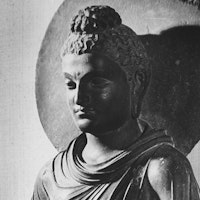The Noble Truth of the Path leading to the cessation of suffering is this Noble Eightfold Path…
Gautama Buddha

The Noble Eightfold Path
Theme: Eternal Truth
The Noble Truth of the Path leading to the cessation of suffering is this Noble Eightfold Path, namely: right view, right aspiration, right speech, right action, right livelihood, right effort, right mindfulness, right concentration.
What is right view? Knowledge of suffering, knowledge of the arising of suffering, knowledge of the cessation of suffering, knowledge of the path leading to the cessation of suffering―this is called right view.
What is right aspiration? Aspiration for renunciation, aspiration for non-malevolence, aspiration for harmlessness―this is called right aspiration.
What is right speech? Refraining from lying speech, refraining from slanderous speech, refraining from harsh speech, refraining from gossip―this is called right speech.
What is right action? Refraining from violence against creatures, refraining from taking what has not been given, refraining from going wrongly among the sense-pleasures―this is called right action.
What is right livelihood? A disciple of the Noble Ones, getting rid of a wrong mode of livelihood, makes his living by a right mode of livelihood. This is called right livelihood.
What is right effort? A monk generates desire, effort, stirs up energy, exerts his mind and strives for the non-arising of evil unskilled states that have not arisen… for the getting rid of evil unskilled states that have arisen… for the arising of skilled states that have not arisen… for the maintenance and completion of skilled states that have arisen. This is called right effort.
What is right mindfulness? A monk fares along contemplating the body in the body… the feelings in the feelings… the mind in the mind… the mental states in the mental states… ardent, clearly conscious of them, mindful of them so as to control the covetousness and dejection in the world. This is called right mindfulness.
And what is right concentration? A monk, aloof from the pleasures of the senses, aloof from unskilled states of mind, enters on and abides in the first meditation which is accompanied by initial thought and discursive thought, is born of aloofness, is rapturous and joyful. By allaying initial thought and discursive thought, with the mind subjectively tranquilized and fixed on one point, he enters on and abides in the second meditation which is devoid of initial thought and discursive thought, is born of concentration, and is rapturous and joyful. By the fading out of rapture… he enters on and abides in the third meditation… the fourth meditation. This is called right concentration.
Gautama Buddha, also known as Siddhartha Gautama, was a spiritual teacher and the founder of Buddhism. Born in the 6th century BCE in Lumbini, now modern-day Nepal, he was destined for greatness. At the age of 29, he renounced his luxurious life as a prince and embarked on a spiritual quest to find the ultimate truth about human suffering and the nature of existence.
After years of intense meditation and self-discipline, Gautama attained enlightenment under a Bodhi tree in Bodh Gaya, India, at the age of 35. He became the Buddha, which means "the awakened one" or "the enlightened one." Gautama Buddha spent the rest of his life teaching the Four Noble Truths and the Eightfold Path, which formed the core principles of Buddhism. His teachings emphasized the importance of overcoming desire and attachment to achieve liberation from suffering. Known for his compassion and wisdom, Gautama Buddha's teachings have had a profound impact on millions of people worldwide, inspiring them to seek inner peace and spiritual enlightenment. His legacy as a spiritual leader and philosopher continues to resonate and guide individuals on their spiritual journeys to this day.
Majjhima Nikaya
Wilson, Andrew, editor. World Scripture - a Comparative Anthology of Sacred Texts. Paragon House, 1991, p. 113 [Majjhima Nikaya iii. 251-52, Saccavibhangasutta].

Gautama Buddha
Theme: Eternal Truth
Copyright © 2017 – 2025 LuminaryQuotes.com About Us

The Decalogue and The Noble Eightfold Path
The moral outlooks of most religions are basically quite similar. Just as the Decalogue, or Ten Commandments, is the basis of Jewish and Christian ethical values, similar lists of ethical principles may be found in one form or another in the scriptures of most religions. The Qur’an contains several passages summarizing proper ethical behavior which have been called Islamic Decalogues. In Buddhism, Hinduism, and Jainism we find lists of ten charges or ten precepts for monks and laypeople, and there are further condensations into five universal dharmas called samanya dharma. Another comparable list is found in the Buddhist Eightfold Path.
The first table of the Decalogue contains positive injunctions for right worship to establish a proper vertical relationship with God, and the second table contains negative injunctions prohibiting criminal behavior in order to foster horizontal relationships of community. These two ethical dimensions, the vertical towards the Absolute and the horizontal towards one’s neighbor, are characteristic of such lists in every religion. We may regard the injunctions to renunciation and meditation in the Buddhist Eightfold Path and in other Hindu, Buddhist, and Jain lists of dharmas as non-theistic expressions of the vertical dimension. In the horizontal dimension of law, prohibitions against social crimes such as murder, adultery, and stealing are universal.